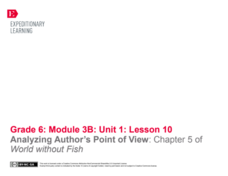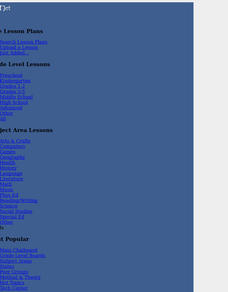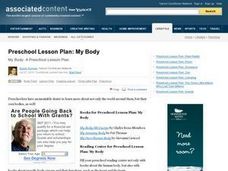EngageNY
Analyzing Author’s Point of View: Chapter 5 of World without Fish
That's an interesting perspective. Scholars read chapter five of World without Fish and use an Author’s Point of View graphic organizer to determine the author's perspective. In triads, they highlight words that support the author's...
Curated OER
All Aboard!
Learners recognize and identify onomatopoeia. They will read the book All Aboard! A True Train Story, by Susan Kuklin. After reading the book, they list and illustrate examples of onomatopoeia. Then they write a poem or...
Curated OER
Pairing Picture Books with Edith Hamilton's Mythology
As a before reading strategy, class members select a tale from mythology, examine several picture book versions of the myth, and fill out part of a Venn diagram with observations about the hero in particular and the myth in...
Curated OER
The Things They Carried: KWHL
Before beginning The Things They Carried, class members are asked to use a KWHL chart to record what they know about war, what they want to know, and where they might find answers to their questions. Groups then research...
Brigham Young University
Out of the Dust: KWHL Strategy
A K-W-H-L chart is a great way to scaffold prior knowledge. As class members begin their reading of Out of the Dust, Karen Hesse’s 1998 Newbery Medal winning verse novel, they chart what they already know about the Great Depression...
Curriculum Corner
Digraph Word Hunt
Support young learners with developing their spelling skills and ready fluency with this simple graphic organizer. Focusing on the four consonant digraphs /th/, /ch/, /sh/, and /wh/, students dig through their independent reading books...
Curated OER
Five Parts That Contribute to the Whole
Students listen to and read an online story. Then they use a graphic organizer to learn the basic story elements. They select another online story and create a graphic organizer for its story elements.
Apple State University
Friendly Letter Mini-Lesson
This mini-lesson about informal letter writing is packed with a lot of information about writing a friendly letter. Class members begin by working in pairs to answer questions after reviewing letter models. Then, take part in a grand...
K12 Reader
It’s Elemental
This comprehension learning exercise provides readers with an article about basic matter and then asks them to use this information to respond to a series of comprehension questions.
Novelinks
The Lion, the Witch, and the Wardrobe: Picture Book Strategy
Picture books aren't just for primary learners. Your scholars compare and contrast literary themes between the novel, The Lion, the Witch, and the Wardrobe by C.S. Lewis, and the children's book, The Dream Tree by Winfried...
ReadWriteThink
What is Poetry? Contrasting Poetry and Prose
Introduce middle schoolers to the different strategies used when reading prose versus poetry. Groups use a Venn diagram and a poetry analysis handout to compare the characteristics of an informational text and a poem on the same...
Novelinks
Man's Search for Meaning: K-W-H-L Strategy
Prior to reading Viktor Frankl's Man's Search for Meaning, class members use the provided worksheet to list what they know about the Holocaust, what they want to know, and how they will find the information they seek. After...
Curated OER
How Do Adjectives Improve Writing?
Using adjectives to create vivid descriptions is the focus of exercises in this resource. A cloze reading activity asks class members to add missing adjectives to passages from Mark Teague's The Lost and Found. They then read...
Curated OER
Colonial Newspaper Template
Partners produce a colonial newspaper that includes news articles, advertisements, want ads, and more using this handy template.
Curated OER
The Big Sneeze
Students participate in a variety of shared reading and writing activities related to the book "The Big Sneeze" by Ruth Brown. They develop a list of farm vocabulary, sequence the events of the story on a graphic organizer, act out...
Curated OER
Vocabulary Strategy: Call of the Wild
Here is a strategy for groups to contribute to whole class vocabulary development. Teams (based on seating rows) work together to look up dictionary definitions of words from upcoming sections of the book (though previous sections seem...
K12 Reader
Repeated Subtraction Is Division
Here's a reading comprehension instructional activity that not only provides a skill building opportunity but also introduces readers to the idea of repeated subtraction.
Poetry Society
Simile and Metaphor
Young poets use word cards to prompt a metaphor poem comparing to very dissimilar items.
Curated OER
Compare and Contrast: Miss Nelson is Missing
Compare and contrast two characters from the book Miss Nelson is Missing. Using a Venn Diagram, have pupils compare and contrast personal characteristics between Miss Nelson and Miss Swamp. Individuals can then share their responses with...
Curated OER
Discussion Web
Get your class talking, even debating, about Gary Paulsen's popular novel Canyons. As they finish chapters 10-12, they complete the following discussion web concerning Brennan and the skull. They fill out the graphic organizer provided...
Curated OER
Fiction: Reading and Responding
Learners respond and make predictions as they read an excerpt from The True Confessions of Charlotte Doyle. For this The True Confessions of Charlotte Doyle lesson, students read aloud and respond to questions that require them to...
Curated OER
Energy
Scientific terms can be difficult to remember. This resource suggests developing analogies as a way to make energy terms memorable. After listing new terms on the board, groups develop analogies based on restaurant words, and then share...
Curated OER
"My Body"
Students participate in various shared reading and writing activities related to the book "My Body" by Rhonda Jenkins. They identify and list words that could be used to label other body parts in the book, draw a picture of their face...
Curated OER
"My Holiday Diary"
Students participate in a variety of shared reading and writing activities related to the book "My Holiday Diary" by Jason Telford. They scan the text to locate specific information, write a statement taken from the text and change it...























